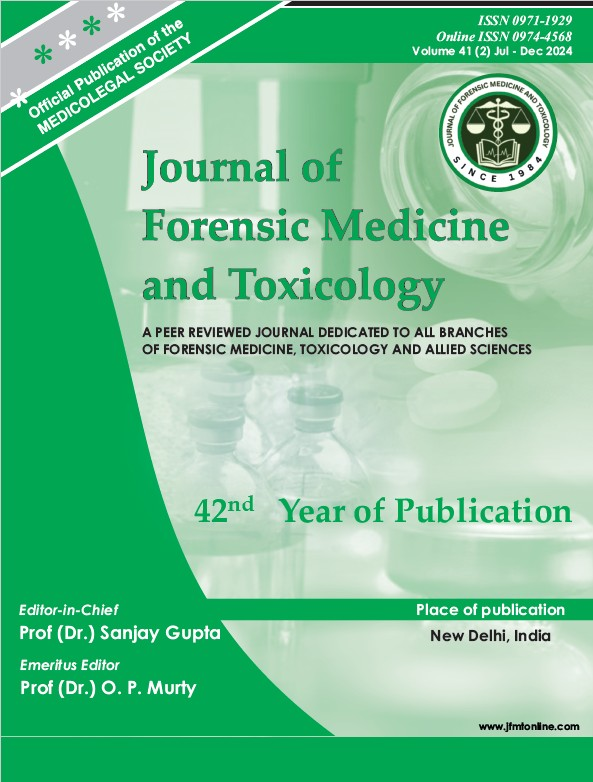DEATH BY SEAT BELT COMPRESSION : A CASE REPORT
DOI:
https://doi.org/10.48165/jfmt.2024.41.1.24Keywords:
Accidents, Seat belt, AutopsyAbstract
Background: With the advent of car seat belts, there has been a significant decrease in the number of deaths due to car accidents. However, two unique patterns of injuries, the ‘seat belt sign’ and ‘seat belt syndrome’ have emerged. Fractures of the sternum, rib cage, clavicles, and injuries to abdominal organs are potential injuries that may occur. Case: We are presenting the case of a 25-year-old male who was a restrained rear-seat passenger in a car versus truck collision, brought for a medical-legal autopsy. The physical examination showed a diagonal contusion across the chest and a horizontal contusion on the abdomen. Upon careful examination, we observed the presence of the ‘seat belt sign’ and ‘seat belt syndrome’. Conclusion: The diversity of organ injuries due to seat belts includes all possible combinations, and the deceased with a seat belt sign have a higher likelihood of having internal injuries.
Downloads
References
Herath M, Bautz P, Parker D, Dobbins C. The importance of wearing a seatbelt correctly - A case report of blunt trauma causing complete shearing transection of the gastroduodenal junction. Int J Surg Case Rep. 2020;72:197–201.
Luchini D, Sammicheli M, Cortucci C. The effect of rear-seat overloading in a car crash: Pathological and kinematics evidences. Am J Forensic Med Pathol. 2013;34(3):177–80.
Saukko P, Knight B. Knight’s Forensic Pathology. 4th ed. New York: CRC; 2016.p.284-6.
Cornelissen MP, Buijtenen VJ, Heuvel B, Bloemers F, Geeraedts L Jr. Blunt abdominal wall disruption by seatbelt injury; A case report and review of the
literature. Bull Emerg Trauma. 2016;4(2):105–9.
Torba M, Hijazi S, Gjata A, Buci S, Madani R, Subashi K. Seat belt syndrome, a new pattern of injury in developing countries. Case report and review of literature. G Chir. 2014;35(7–8):177–80.
Greenston M, Wood RL, Reinhart L. Clinical significance of the seat belt sign as evidence of a compromised occupant-seat belt relationship. J Emerg Med. 2019;56(6):624–32.
Byard RW, O’Donovan S, Gilbert JD. Seat belt asphyxia as a lethal mechanism in motor vehicle crashes. Forensic Sci Med Pathol. 2021;17(2):343–5.
Najari F, Alimohammadi AM. An immediate death by seat belt compression; A forensic medicine report. Emerg. 2015;3(4):165–7.
James RA, Byard RW. Asphyxiation from shoulder seat belts: An unusual motor vehicle injury. Am J Forensic Med Pathol. 2001;22(2):193–5.




